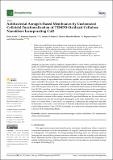Por favor, use este identificador para citar o enlazar a este item:
http://hdl.handle.net/10261/340177COMPARTIR / EXPORTAR:
 SHARE SHARE
 CORE
BASE CORE
BASE
|
|
| Visualizar otros formatos: MARC | Dublin Core | RDF | ORE | MODS | METS | DIDL | DATACITE | |

| Título: | Antibacterial Aerogels-Based Membranes by Customized Colloidal Functionalization of TEMPO-Oxidized Cellulose Nanofibers Incorporating CuO |
Autor: | Usala, Elena; Espinosa, Eduardo; El Arfaoui, Wasim; Morcillo-Martín, Ramón; Ferrari, Begoña CSIC ORCID ; González, Zoilo | Palabras clave: | Colloidal heterostructures Functional aerogels Cellulose nanofibers CuO nanoparticles Antibacterial membranes |
Fecha de publicación: | nov-2023 | Editor: | Multidisciplinary Digital Publishing Institute | Citación: | Bioengineering 10(11): 1312 (2023) | Resumen: | An innovative colloidal approach is proposed here to carry out the customized functionalization of TEMPO-Oxidized Cellulose Nanofibers (CNF) incorporating non-noble inorganic nanoparticles. A heterocoagulation process is applied between the delignified CNF and as-synthetized CuO nanoparticles (CuO NPs) to formulate mixtures which are used in the preparation of aerogels with antibacterial effect, which could be used to manufacture membranes, filters, foams, etc. The involved components of formulated blending, CNF and CuO NPs, were individually obtained by using a biorefinery strategy for agricultural waste valorization, together with an optimized chemical precipitation, assisted by ultrasounds. The optimization of synthesis parameters for CuO NPs has avoided the presence of undesirable species, which usually requires later thermal treatment with associated costs. The aerogels-based structure, obtained by conventional freeze-drying, acted as 3D support for CuO NPs, providing a good dispersion within the cross-linked structure of the nanocellulose and facilitating direct contact of the antibacterial phase against undesirable microorganisms. All samples showed a positive response against Escherichia coli and Staphylococcus aureus. An increase of the antibacterial response of the aerogels, measured by agar disk diffusion test, has been observed with the increase of CuO NPs incorporated, obtaining the width of the antimicrobial “halo” (nwhalo) from 0 to 0.6 and 0.35 for S. aureus and E. coli, respectively. Furthermore, the aerogels have been able to deactivate S. aureus and E. coli in less than 5 h when the antibacterial assays have been analyzed by a broth dilution method. From CNF-50CuO samples, an overlap in the nanoparticle effect produced a decrease of the antimicrobial kinetic. | Versión del editor: | https://doi.org/10.3390/bioengineering10111312 | URI: | http://hdl.handle.net/10261/340177 | DOI: | 10.3390/bioengineering10111312 | E-ISSN: | 2306-5354 |
| Aparece en las colecciones: | (ICV) Artículos |
Ficheros en este ítem:
| Fichero | Descripción | Tamaño | Formato | |
|---|---|---|---|---|
| Antibacterial-Aerogels_Art_2023.pdf | 4,87 MB | Adobe PDF |  Visualizar/Abrir |
CORE Recommender
Page view(s)
29
checked on 05-may-2024
Download(s)
20
checked on 05-may-2024
Google ScholarTM
Check
Altmetric
Altmetric
Este item está licenciado bajo una Licencia Creative Commons

